As the University re-opens under Alert Level 2, and life takes on a new normal following the COVID-19 lockdown, Communications Adviser (Projects) Sean Flaherty takes a closer look at Otago's ongoing response to the global pandemic.
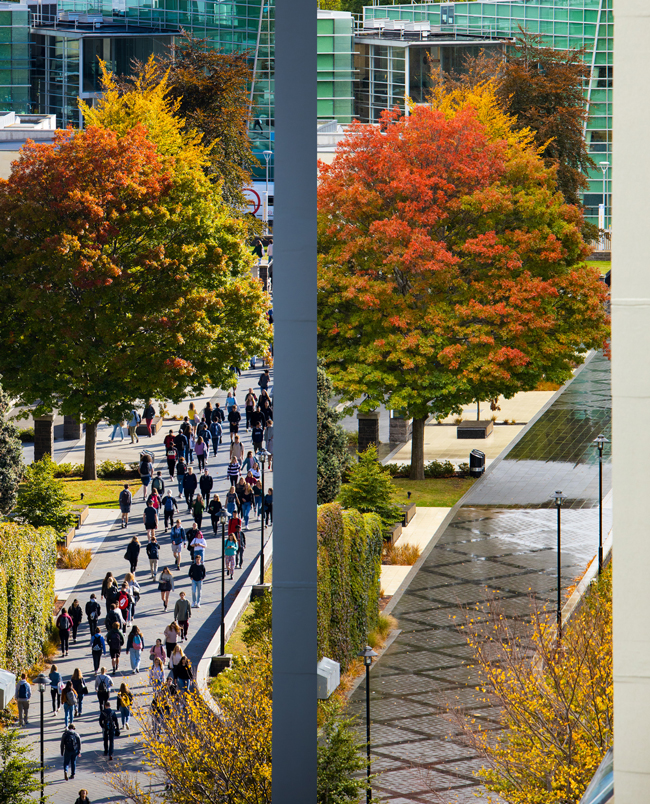
The University before and during the COVID-19 lockdown. Photo: Dave Bull.
In mid-January, before the longest March anyone could remember, a call came into the University of Otago's International Office.
It was from a student in Wuhan, the centre of the coronavirus outbreak.
“He was really distressed, he was yelling down the phone 'I'm trapped, I can't come to university, they've closed the borders, people are dying, most of us don't even know what's going on, what can I do?'” remembered Danielle Yamamoto Kerr, Otago's Manager of International Student Services.
The team asked him to stay calm. They would get some more information and work something out. Solving problems for Otago's international students is a large part of what this office does.
There seemed plenty of time. The Otago campus was just stirring back to life for the 2020 academic year. Surely the situation would settle down and this student be able to get to Dunedin for semester 1 in late February.
A couple of days later a student came to the International Office.
"She was a young student. She was visibly upset. She told us that her parents were both doctors in Wuhan and she wanted to show us a video on her phone of a hospital waiting room."
“She was a young student. She was visibly upset. She told us that her parents were both doctors in Wuhan and she wanted to show us a video on her phone of a hospital waiting room. She said to us 'I don't know what to do, I want to go home to be with my family, but they want me to stay here where it's safe, what should I do? Tell me what to do. What's the best answer for me?”
COVID-19 was no longer far away. It was getting closer by the day.
The focus at this point was on more than 200 Chinese students who were unable to travel to New Zealand to start or continue their studies at Otago.
The calls and emails from these students began to grow and the International team worked with the Chinese Students' Association to provide support and information. The situation was changing so rapidly that in many cases there were simply no answers.
“For my teams, whose daily work involves laying out known options for students and helping them make decisions based on that, having no tools, no precedents, no answers for all of these new questions that were being asked was pretty frustrating and often a little disheartening.”
These were uncertain days. The virus was spreading through northern Europe and every day the looming impact of COVID-19 was becoming clearer. But the full lockdown which shut down New Zealand and virtually emptied the Dunedin campus of its 20,000 students was still many weeks away. Nobody knew exactly what was going to happen.
International Office Director Jason Cushen now looks back at January and February as the calm before the real storm.
“I spent a lot of time saying to my team: It's OK to not have the answers because simply the answers are not there yet, these were unprecedented circumstances. It might take three or four days to get an answer by which stage we would need answers for a different set of questions. It was surreal.”
But solutions were on their way. The University's Pandemic Committee met in February and work began on ensuring this group of stranded students could continue their studies remotely where possible. This initial work to support this group provided the basis for Otago's move to full online learning which has secured the continuation of the academic year for all students.
“In February it was almost unimaginable that first year Health Sciences would be online, yet it was possible by March. It was amazing how this situation evolved,” Mr Cushen says.
With circumstances changing by the day, the group of 200 students stranded in China became a subset of a much larger group.
Around 1,800 international students were already in New Zealand, and many were thinking about going home.
In addition, Otago had 220 students scattered around the world on exchange who were also thinking of returning. International routes were closing. Some had to make two or three airline bookings but happily all who wanted to come back to New Zealand made it.
"It was pretty tough. Some of them were really torn between what their home universities and colleges were saying because they felt quite safe here."
In early March came a tipping point. The United States called its students home, which for the International Office involved face-to-face meetings with hundreds of students.
“It was pretty tough. Some of them were really torn between what their home universities and colleges were saying because they felt quite safe here. Remember by this stage we had the daily updates on TV and could see for ourselves the profound impact of Covid-19 in countries like Italy. They were genuinely conflicted about what to do. We were encouraging them to make this decision with their families.”
In the end, over a fraught two-week period, about 400 students decided to return home. All but a few of this group continued to study online.
The vast majority of the international cohort – about 1,500 students – have remained and are continuing their degrees in New Zealand using Otago's rapidly constructed online learning environment.
The International Office has replaced its face-to-face contact with students with daily Zoom cafes and welfare checks by phone.
“What's been really interesting is having to maintain that distance to help manage student anxieties while putting aside our own anxieties about all of this and being able to present a face to students like: 'We got this'. When sometimes we don't really. We absolutely continue to support them and let them know they made a good decision to stay here. And we're really looking forward to seeing our students again,” Danielle says.
Otago researchers call for lockdown
By April New Zealanders had become accustomed to the gritty practicalities of lockdown and the daily 1pm update of COVID-19 deaths and new cases.
But in March it was a very different story. The Ministry of Health had yet to push the button for a drastic pandemic response.
As New Zealand prevaricated on adopting stringent control measures, Otago Public Health researchers were among the first to sound the alarm of the looming emergency.
Their calls to action had a direct impact on Government decision-making and they are now among the most prominent public faces of New Zealand's widely praised evidence-based response.
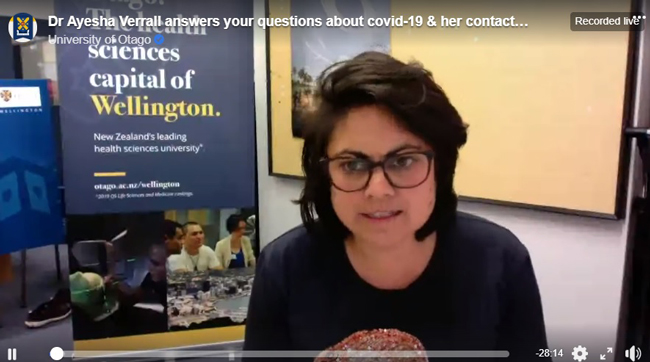
Dr Ayesha Verrall of the University of Otago Wellington answers virus-related questions during one of her regular Facebook Live sessions.
“My profile is a function of very strange and unusual circumstances like the fact there was no other news because every other part of society was shut down. There were no rugby players and no celebrities, so epidemiologists were the celebrities for four weeks,” laughs Dr Ayesha Verrall, a Senior Lecturer in the Department of Pathology and Molecular Medicine at the University of Otago, Wellington.
On 23 March, her colleague Professor Michael Baker warned of the dire consequences of a delayed lockdown on the national news website Stuff.
With New Zealand at a fork in the road, this was by no means a universal view at the time.
"All I can do is convey the epidemiological rationale for doing it very rapidly," Professor Baker told Stuff, "The alternatives are pretty dire."
As the Professor of Public Health at the University's Wellington campus, and one of New Zealand's leading epidemiologists, Professor Baker was well qualified to make this call.
He and his colleague Professor Nick Wilson, of Wellington's Department of Public Health, had become convinced of the need for a lockdown after reading a World Health Organisation report on China which showed the effectiveness of a containment strategy.
In a follow-up story just two weeks later, Professor Baker was described as “the man for this moment” with modelling undertaken by himself and Professor Wilson directly informing Government policy.
In mid-April he was awarded a $500,000 Government grant for a project to guide an effective and equitable pandemic response and to learn as much as possible, so New Zealand is better prepared for the next major public health emergency. In the same funding announcement Senior Lecturer Lesley Gray, also from the University of Otago, Wellington, received $179,904 for research into self-isolation.
By now Otago academics were in high demand by a media hungry for trusted information. Professor David Murdoch, Dean of the University of Otago, Christchurch, was being called on to explain COVID-19 test results and the steps required to develop a vaccine.
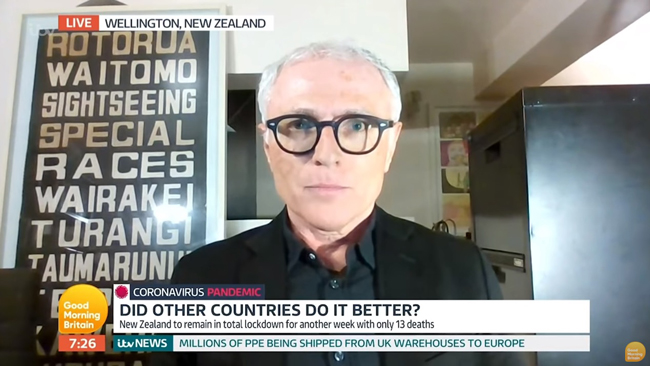
Professor Michael Baker, of the University of Otago Wellington, speaks on Good Morning Britain in April.
Professor Baker was everywhere, appearing on the UK's most watched breakfast TV show and answering real-time reader questions on Stuff. His contributions were becoming synonymous with New Zealand's response to the virus. And he wasn't alone in the spotlight.
Dr Verrall was also plunged into a new world, at one point juggling 20-30 media calls a day with her shifts as an Infectious Diseases doctor at Capital and Coast District Health Board.
Dr Verrall, who teaches microbiology to medical students at the Wellington campus, is a tuberculosis specialist who had used New Zealand's contact tracing system to track TB infection.
She, too, was more than a little worried about New Zealand's COVID-19 response and went public in early March with a call for a rapid scaling up of testing and contact tracing.
Her profile had already been growing through live Facebook videos organised by the University and hosted on the Newsroom website where she answered questions about the virus.
“At that stage (February) there were a lot of questions about 'Was this really a thing?'” she remembers.
"Facebook is a very good direct way of learning what is worrying people ... Doing it from well before the lockdown has felt like going through a journey with people."
“Facebook is a very good direct way of learning what is worrying people so that's really nice engagement and there are very simple questions you're able to help people with. 'Is it safe to touch their groceries' or 'how do they do their hand washing in practice?'
“Doing it from well before the lockdown has felt like going through a journey with people.”
Dr Verrall's own journey as a public academic has accelerated in tandem with the developing emergency.
Just weeks after she first went public with her concerns, she was commissioned by the Government to undertake a rapid review of New Zealand's contact tracing response to COVID-19.
Otago academic Emeritus Professor Sir David Skegg had already made national headlines after telling Parliament's Epidemic Response Committee that failure to improve rapid contact tracing would be like playing "Russian roulette" with the health of New Zealanders.
Dr Verrall now found herself in front of the same committee.
“Part of it was my expertise but I think it's fair to say that when you're a young female academic you don't necessarily get invited to do these sorts of things unless you push. I think the work in the media certainly helped profile myself as someone with knowledge in this area. I was able to establish myself as an authority who could be trusted to write the report.”
It's a role she is comfortable with and hopes to capitalise on in the future to push for improvements in New Zealand's public health system.
“I think we're on the right track with the public health response to COVID-19 now, but the underlying issues have been about decades of under-investment in public health and I'm determined to continue to keep our focus on not letting that slip.
“So, we have now got investment in a strong response to COVID-19 with an increased capacity of public health units and better data systems but it's important to make sure these gains are leveraged for gains in all areas of preventive medicine.
“So that's a project I see in the future. We want to maintain that focus.”
Isolating the virus
While New Zealand was grappling with the impact of the virus, Professor Miguel Quiñones-Mateu was trying to get his hands on it.
Professor Miguel Quiñones-Mateu, a microbiologist who is the Webster Family Chair in Viral Pathogenesis, had just returned from holiday in early January when his colleague Associate Professor James Ussher came into his office.
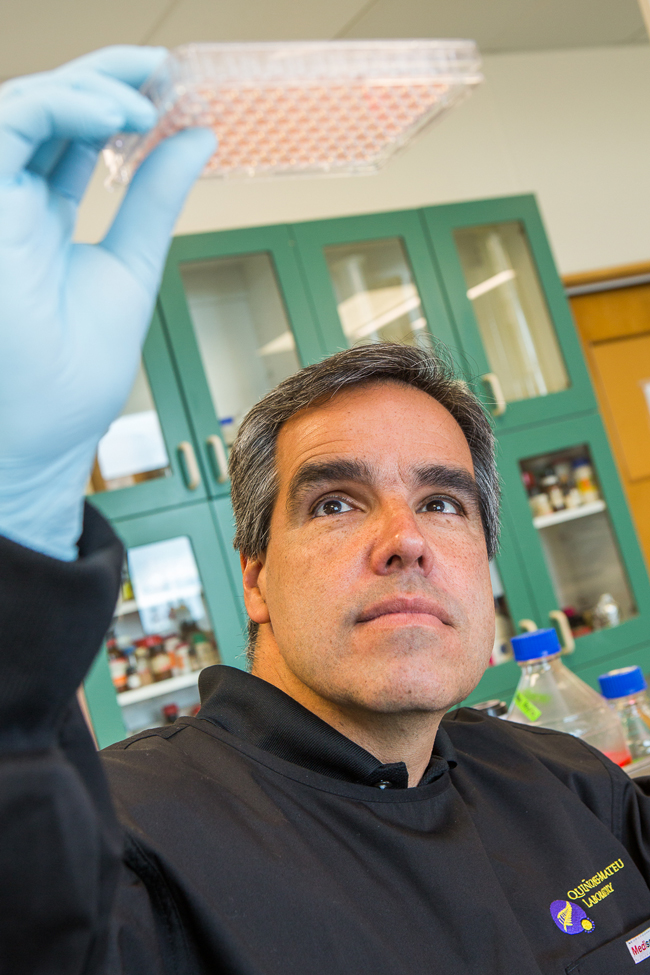
Professor Miguel Quiñones-Mateu, who holds the University's Webster Family Chair in Viral Pathogenesis.
Associate Professor Ussher suggested they use Prof Quiñones-Mateu's previous experience in developing molecular diagnostic tests to work on a test for COVID-19.
At that time New Zealand didn't have a case of the SARS-CoV-2 (the virus responsible for COVID-19) but they knew it was coming and that laboratories would need diagnostic tests.
“James and I just got together and said: 'Let's do this in case this thing hits New Zealand'. Being a virologist, I really wanted to work with the virus. We couldn't wait for everybody else out there to do a job we should be doing here.”
The test they implemented was used to detect Dunedin's first two confirmed COVID-19 cases.
The next step was isolating the virus from patient-derived samples.
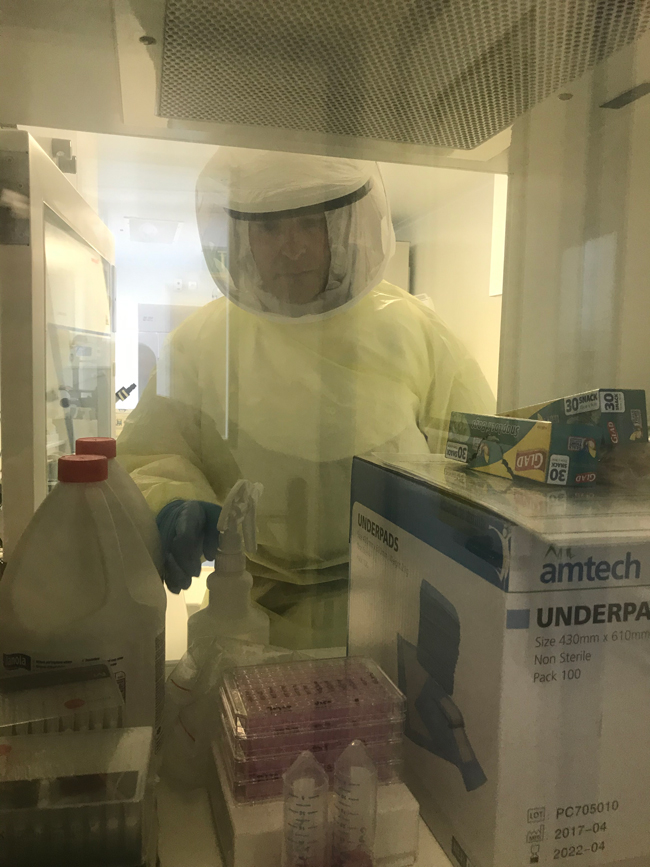
Dr Rhodri Harfoot, a postdoctoral fellow in the Quiñones-Mateu lab, works in full protective clothing.
High above an eerily empty Dunedin campus, researchers in hazmat suits have been using Otago's state-of-the-art PC3 laboratory to do just this.
“That will open the door, not only to make positive controls for diagnostic tests but to do a lot of different studies here in New Zealand. You cannot imagine how many people have been contacting us because they have a product they want to test against SARS-CoV-2, need access to the virus to evaluate sterilisation methods or have plans to develop a COVID-19 vaccine.”
The strength of Otago's diverse and interdisciplinary research programmes is evidenced by the range of research streams which have successfully pivoted to address the threat of COVID-19.
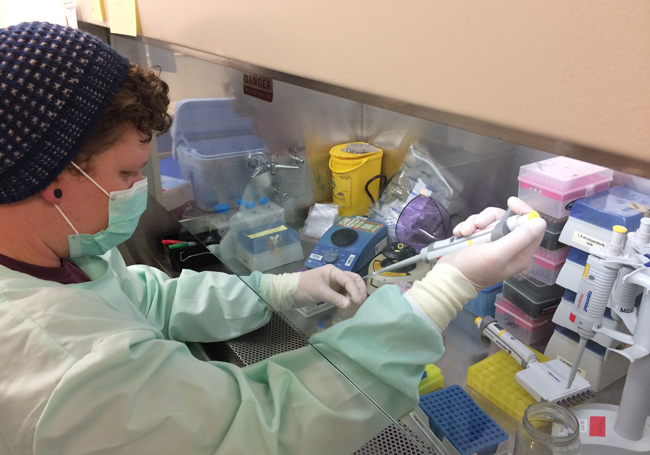
Jackson Treece works on in Jo-Ann Stanton's Anatomy lab.
In the Anatomy Department, Associate Professor Jo-Ann Stanton was already advanced in work to develop hand-held diagnostic technology which can be used as point-of-care testing devices to test for diseases like COVID-19.
She says ruefully that the virus arrived a little too early.
“This has been a very inconvenient pandemic.”
"We have a lot of those pieces so we're going to pull them together into something that's usable quickly ... So, the next time this happens we won't be stuck inside."
Her research has been recognised by a Health Research Council grant which will help fund a multidisciplinary team of both academic and commercial experts, together with rural Māori communities and primary healthcare providers to develop a test to screen patient samples for COVID-19 at the point-of-care, whether that be at a doctor's clinic or the airport.
“If you think about COVID-19 what do we need? We need something that can go anywhere and test anybody for presence of the virus and that is the device that we are in the process of inventing.
“We have a lot of those pieces so we're going to pull them together into something that's usable quickly and that will inform future development of an all in one black box testing platform.
“So, the next time this happens we won't be stuck inside.”
Her colleague Professor Neill Gemmell, who made global headlines with his Loch Ness monster research, is part of a national team looking at testing sewage for the virus.
The hope is that this will provide a downstream tool to detect infection spread and possible alert system to reveal undetected outbreaks.
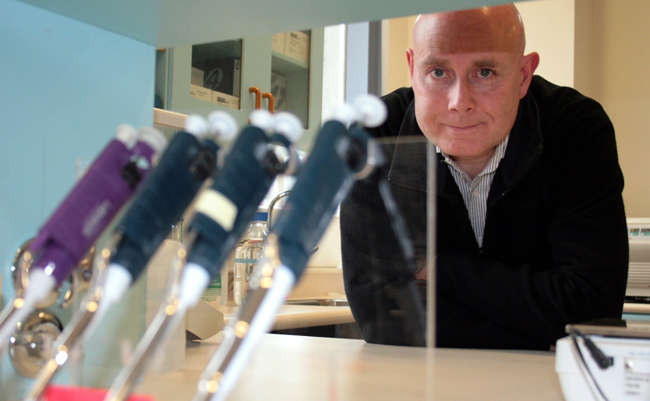
From monster hunter to virus hunter ... Professor Neil Gemmell is part of a national group hoping to find a way to detect coronavirus in wastewater.
While the country was still under a restrictive Level 4, Otago Psychology lecturer Damian Scarf moved quickly to investigate New Zealanders' attitudes towards government authority.
He and his team created a 15-minute questionnaire on lockdown life which garnered 3,500 responses.
“We're particularly interested in whether crises like COVID-19 change people's political beliefs and whether these changes are maintained as we go down the lockdown levels and the risk of COVID-19 decreases.”
Other COVID-19-related research activities are taking place in the schools of Food Science, Economic, Management, Tourism, Geography and Psychology.
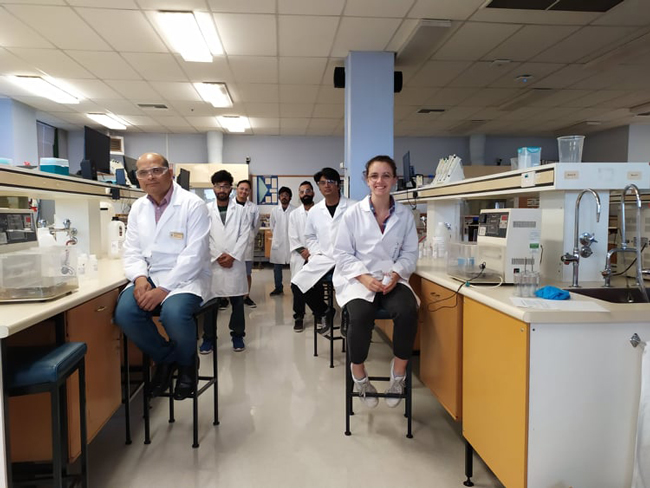
Dr Shyamal Das (left) and his team (from left) Rishi Shah, Prakash Khadka, Tushar Saha, Bishal Adhikari, Rakesh Bastola and Nicole Wood made hundreds of litres of hand sanitiser.
In the School of Pharmacy, Dr Shyamal Das rolled his sleeves up and got on with it, leading postgraduate students on an in-house project to produce 100 litres of hand sanitiser, enough for essential services on the University's Dunedin campus over the following weeks.
Six of his students helped to produce an ethanol-based hand rub, volunteering their time in the face of the escalating Coronavirus crisis.
The move to online
The University of Otago has a vibrant student culture which attracts young people from all over New Zealand and the wider world.
A key component of this is the quality of its face-to-face teaching. So, it was a major philosophical and technical challenge to be suddenly forced to make the transformation to distance learning.
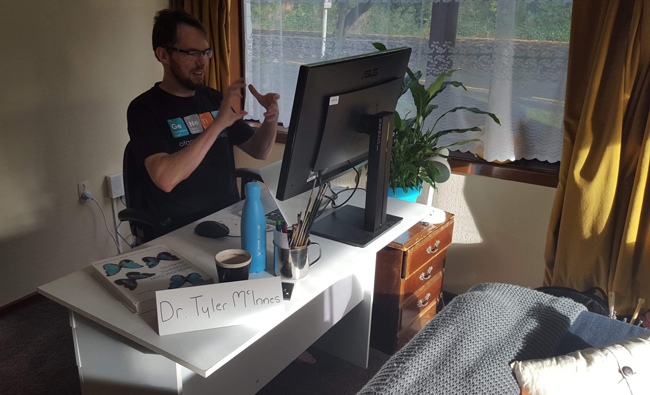
Dr Tyler McInnes of the Genetics Otago Teaching Programme leads a class via Zoom.
In a report to the University Council on 15 April, Vice-Chancellor Professor Harlene Hayne acknowledged the magnitude of this transition and the many moving parts across academic divisions and Information Services which had to synchronise at great speed.
“Staff across all divisions have responded quickly and professionally, prioritising the needs of their students during this very challenging time. The huge amount of preparation undertaken has proved invaluable and our staff have embraced the challenges of online teaching in many creative ways.”
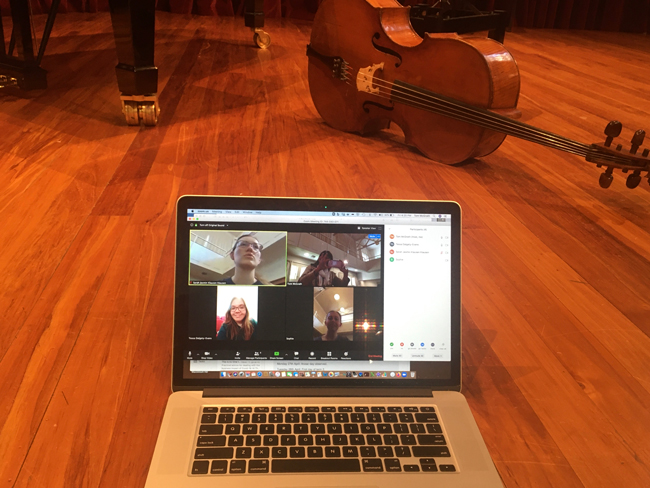
A pre-lockdown Zoom performance class practice led by Dr Heleen du Plessis.
Moving an entire University's teaching programme online is a serious undertaking and preparations started weeks prior to the eventual move.
Professor Richard Barker, the Pro-Vice-Chancellor of Sciences, compared his role to that of the captain on the bridge of a ship “whose every decision triggers an awful lot of activity in the engine room”.
Preparations for online teaching had been under way since February to support the students stranded in China. So, by the time the decision was made to move the whole University online there was a level of confidence that it could be achieved.
"Between a Friday and a Monday, we realised we're going online for everybody and we're going to be doing it by next week. So that's how rapidly it evolved."
“Between a Friday and a Monday, we realised we're going online for everybody and we're going to be doing it by next week.
“So that's how rapidly it evolved. But because we'd gone through the exercise with the students stuck in China and we'd already had the conversations about a significant number of our courses, we were well-placed to be able say 'Yes we can do this. It won't be perfect but we're confident we can do it'.”
On the technical side, academic staff from Distance Learning, HEDC and the College of Education, in conjunction with IT Services, produced a website on Blackboard called Shifting Online and ran workshops to assist staff with learning about online delivery and assessment. The Director of Student Success and others helped assisting students.
Meanwhile staff were scrambling to improvise solutions for coursework.
Associate Professor James Scott, of the Department of Geology shot down to Fiordland with a camera to make location videos to replicate the experience of a student field trip.
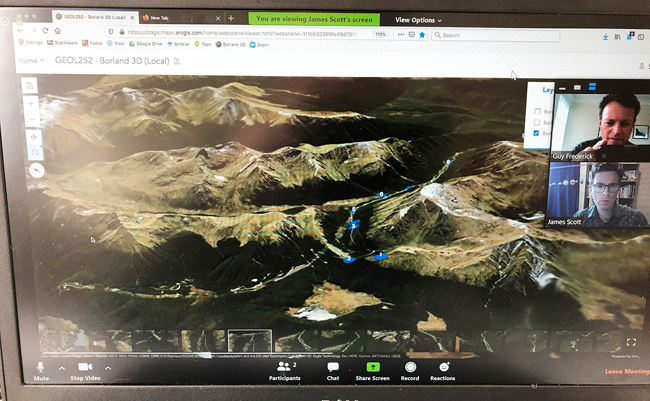
Associate Professor James Scott shows Communications Adviser Guy Frederick the virtual landscape he created following a whirlwind trip to Fiordland to photograph and video important geological spots for a lockdown COVID-19 field trip.
Virtual versions of other field trips were also quickly produced and transferred to digital platforms.
Dr Christian Ohneiser and Dr Sophie Briggs spent a day on the Taieri Plain capturing footage introducing the geology and hydrological systems of the area, which was then edited into a 25-minute animated video with the help of Geological Mapping Technician Stephen Read over four days.
With his dog in tow, Professor Mark Stirling ventured out to create a virtual field trip on natural hazards with a focus on the local Akatore Fault and Abbotsford Landslide.
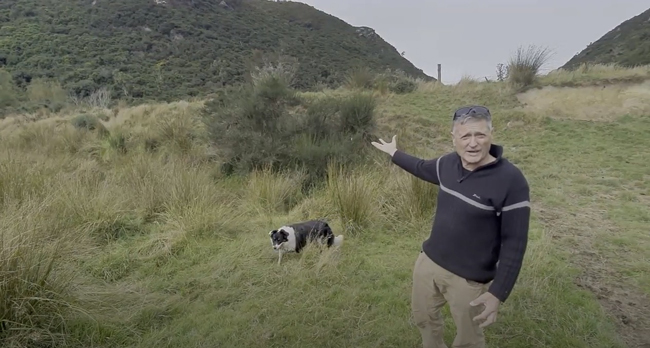
Professor Mark Stirling and his dog film clips for a virtual field trip on natural hazards.
In the laboratories, teaching staff filmed laboratory work to give students content for their lab reports.
“Good scientists tend to be creative people,” says Professor Barker. “I'm very proud of how the Division responded.
“From students, the response has been overwhelmingly positive. I don't believe the online experience is as good as they would have got if they were in class but I think they're very understanding of the situation that they're in and appreciative of the fact that the material they've been provided allows them to get on with their studies.”
Supporting students
Hand-in-hand with the academic and teaching response has been the work to support students.
In a University flat close to the heart of a deserted Dunedin campus, Otago University Students' Association (OUSA) President Jack Manning jumps from Zoom meeting to Zoom meeting.
"I realised if I'm being called in this must be big. And going into the Clocktower and suddenly hearing with everyone else that New Zealand was moving the Alert Level 4; it was a paradigm shift."
He and his team have found themselves at the nexus of the University response, translating student needs and expectations as each day brings new and unexpected challenges.
“We knew COVID had the potential to have a very significant impact early on and the Uni brought us into their daily incident management meetings. But we certainly had no idea to just what extent it would actually impact our daily lives.”
He clearly remembers the day he got an invitation to meet Professor Hayne at noon in the Clocktower.
“I realised if I'm being called in this must be big. And going into the Clocktower and suddenly hearing with everyone else that New Zealand was moving the Alert Level 4; it was a paradigm shift.
“We'd done as much as we could and worked with the University and given guidance but that was the day I realised: 'Wow, everything about being a student at Otago is about to change quite significantly'.”
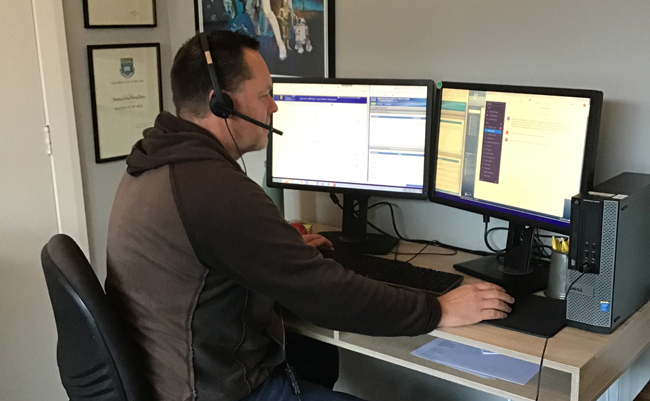
Jon Adams, an AskOtago Service Representative, makes welfare checks from his home office.
At ground-level the University's on-campus helpdesk AskOtago has been providing personal welfare checks for almost 2,000 students and staff.
The team is staying in contact via email and phone calls which cover general health and wellbeing with a brief to direct students to any services they might need.
“We know for our students living alone we are a connection to the outside world and take this responsibility seriously,” says AskOtago Senior Manager Philippa Hoult.
Third-year anthropology student Timothy McRobbie, living alone in private accommodation, told the Otago Bulletin Board he had found the wellbeing checks “invaluable”.
“Having someone communicate with me on a regular basis is really helpful and supportive for me. Some days AskOtago is the only contact I receive from the outside world,” Mr McRobbie explains.
Uncertainty was in the air as the University's Dunedin campus began to empty as students in residential colleges and flats made the decision to return home. The questions began to mount. Students wanted answers quickly. Could they continue their courses remotely?
"We've seen a tremendous amount of resilience from students. The immense amount of support has been incredible. It is very telling of the character of Otago students."
Regular meetings with the Vice-Chancellor have been welcomed and Jack is hopeful of keeping OUSA positioned in this space.
“The urgency of the situation has been met with a high level of student representation in decision-making and OUSA has welcomed that very happily and we hope that has set a new standard for the amount of student consultation that takes place.
“Initiatives like the student hardship fund and digital exams have all been heavily consulted on.”
It hasn't all been work, with the OUSA executive taking time to make daily videos on Instagram to connect with the student community.
One very funny clip shows residential representative Jack Saunders demonstrating how to use salad spoons as hands to get around the need to wear gloves. It's well worth checking out.
“That's one of the great things about OUSA. It's just students connecting to other students,” Jack says.
“We've seen a tremendous amount of resilience from students. The immense amount of support has been incredible. It is very telling of the character of Otago students.
“They're very supportive of each other and of the wider community and those who are most vulnerable. Everyone feels uncertainty but I'm also seeing students handling this tremendously well.”
Alumni answer the call
Pastoral care for students is at the heart of Otago, and senior leaders recognised early on that student hardship would be an issue as time passed and students lost part-time and family income as well as dealing with their studies.
In late April, the University announced a $1.5 million welfare fund for students facing financial hardship.
Named Pūtea Tautoko, which translates as “financial support”, the fund is a way for the University community to support its students facing the greatest need in extraordinary times.
Professor Hayne announced she was donating 20 per cent of her salary over six months to the fund, a move matched by University Council members.
"This is the most collaborative appeal I've ever been involved with, with the Vice-Chancellor, Human Resources, Communications, OUSA and DARO all working together – and swiftly too."
A call to Otago alumni for contributions met with an immediate response and the money started flowing in.
The University's Development and Alumni Relations Office shared the announcement of the fund via a letter from the Vice-Chancellor, emailed to all alumni and friends.
The response was immediate and unprecedented – in the first hour $12,000 was raised, and by the end of the first week, more than $95,000 had been donated.
Working on the appeal for Pūtea Tautoko has been Development Manager Annual Giving Stephanie Miller's priority during the lockdown.
“This is the most collaborative appeal I've ever been involved with, with the Vice-Chancellor, Human Resources, Communications, OUSA and DARO all working together – and swiftly too.”
Also during this time, significant donations have come in to support the work of Otago academics who have played key roles in the public health and governmental response to COVID-19.
“High profile academics such as Professor Michael Baker have generated a lot of philanthropy at this time, including a $215,000 grant from a donor's trust,” says Director of DARO Shelagh Murray.
Finding a new normal
As New Zealand eases its pandemic alert levels, the University's Dunedin campus is slowly beginning to come back to life.
Professor Hayne is back in her office in the historic Clocktower and familiar campus sounds are drifting through the bluestone walls.
“I can hear lots of giggling outside my office right now,” she says. “The students are coming back.”
"It was like being on a fast-moving river. You had to go with it but try and exert some level of control. We moved quickly, we made decisions, we got resources where they needed to be."
With New Zealand still at Alert Level 2 it will be some time before the full body of students returns.
But the sights and sounds of young people, the lifeblood of the University, are a welcome sign the transition past the worst impacts of the pandemic has begun.
Returning students are learning to negotiate an adjusted campus with round yellow social distancing markers on the walkways and contact tracing registers in the building lobbies.
Offices are filling up again as University staff come back to work. Hand sanitiser is everywhere. Yellow COVID-19 signs dot the walls and doors. Some colleagues' desks are a little further away.
The unpredictability of the strict lockdown period has been replaced by a measured move back to normality.
But nobody, least of all Professor Hayne, is pretending a comprehensive picture exists of what the rest of 2020 will look like.
“My crystal ball doesn't have batteries that last that long,” she says.
What she does know is that the University was severely tested and proved its resilience in a way that gives her confidence it can handle future challenges.
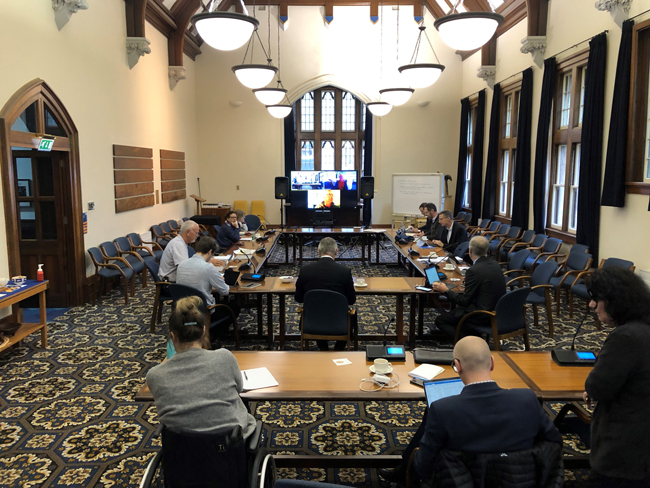
A pre-lockdown Strategic Emergency Management Group Meeting.
In the thick of the lockdown the planning horizon shrank to the next 48 hours which became known as “COVID-time”.
“It was like being on a fast-moving river. You had to go with it but try and exert some level of control. We moved quickly, we made decisions, we got resources where they needed to be.”
Professor Hayne paid tribute to the University's senior leadership team – “I didn't know I was selecting them to go to war with, so to speak, but I'm really glad that these are the people I had with me” - and the vital contribution of student president Jack Manning and his executive team.
“That's been a real key to our success because it keeps us on course and it keeps our moral compass very firmly positioned towards the students.”
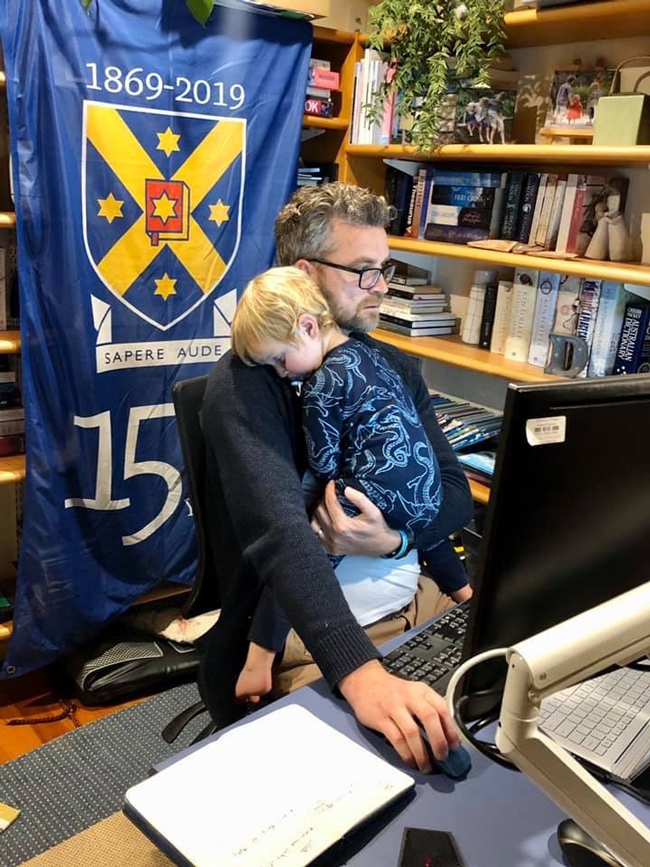
The University's Chief Operating Officer Steve Willis multi-tasks while working from home.
Across the institution, academic and professional staff worked overtime to replicate the collegiate experience online and support students, displaying ingenuity, patience and compassion.
“I have two young adult daughters and the irony was not lost on them that it was the Boomers trying to teach the Zoomers in the online medium that they're much more comfortable in. But our people have gone above and beyond to deliver this rapid shift in the learning environment.
“The Prime Minister talks about New Zealand's team of five million but the University of Otago is our team of 20,000, and everybody is really ready to play on the team.”
Professor Hayne is hopeful the University will be able to resume a large proportion of its face-to-face teaching in semester 2.
"The Prime Minister talks about New Zealand's team of five million but the University of Otago is our team of 20,000, and everybody is really ready to play on the team."
And she's optimistic that Otago will be able to host its international students and teach them on campus in 2021.
“It really depends on how the virus behaves. The big lesson that we learned in the pandemic is we need to be fleet of foot, and we need to be mindful of everything that is happening around us at all times. So, if worse came to worse, and the restrictions were tightened again we would be prepared.”
It is not lost on the senior leadership team that immediately after celebrating its 150th anniversary in 2019, the University faced as stern a test as any in its history.
“It's a really good testament to 150-year tradition that there are so many fundamental values that the University holds that did allow us to continue to exist and in some ways flourish during an international pandemic.
“Think of the amazing contributions that University of Otago staff made to the Government's decision-making – and this is a government that's being held up worldwide as Best in Show.
“I personally feel very fortunate that the same people who were advising the Prime Minister were also advising me.
“We all have this underlying sense of calm, because we had within our own organisation this massive amount of expertise. So, we will take that forward with us into whatever COVID-19 throws at us next.”
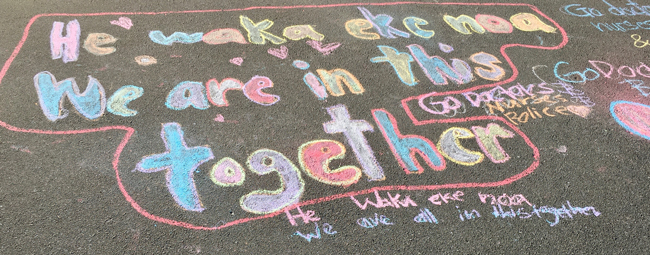
A message of solidarity chalked by the children of a Christchuch-based staff member during lockdown.